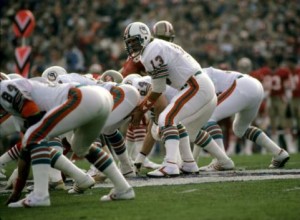So which season is more impressive? That’s a complicated question, and one that could be answered in many ways. In my view, the question boils down to which performance was more outstanding; in mathematical terms, we could define that as which season was farthest from the mean.
To make life a little simpler, I’m going to analyze this question on the team level, meaning we will compare “Denver 2013” to “Miami 1984.” Of course, this approach is preferable in many ways, since when we praise Manning we really mean “Manning with his offensive line and his coaching staff throwing to Demaryius Thomas, Wes Welker, Eric Decker, and Julius Thomas.” And “Marino in 1984” means “Marino and Mark Clayton and Mark Duper and Dwight Stephenson and Ed Newman.”
This season, the Broncos have 51 touchdown passes. The other 31 teams (through 15 games) are averaging 22.8 passing touchdowns, which means Denver is 28.2 touchdowns above average. The standard deviation of the 32 teams in passing touchdowns is 7.4; as a result, we can say that the Broncos are 3.84 standard deviations above average, also known as their Z-score.
In 1984, the other 27 teams (through 16 games) averaged 21.0 touchdowns, while the Dolphins threw 49 scores (Jim Jenson, a college quarterback who played receiver for Miami, threw a 35-yard touchdown to Duper against the Patriots off a Marino lateral). The standard deviation that season in touchdown passes at the team level was 7.5, which gives Miami a Z-score of 3.72 in 1984.
So the Broncos this season have been more extraordinary, at least by this measure. One nice thing about using the Z-score is we don’t need to adjust for games played. I went ahead and calculated the Z-scores for every team since 1932. The current Broncos are #1, with the ’84 Dolphins in second place. The third place team isn’t the Tom Brady 2007 Patriots; that team is down at #7, because the standard deviation in passing touchdowns among the league’s 32 teams was 8.8 that season. Instead, the third slot goes to the 1986 Dolphins. Few remember that Marino threw 44 touchdowns that season; add in Don Strock’s two touchdowns, a lower league average and a smaller standard deviation, and those Dolphins get a Z-score of 3.70.
Let’s look at the top 100 teams using this metric. The 2004 Colts ranked fifth (if you click on the cell in the team column, the link takes you to that team’s PFR page) in Z-score. That year, Indianapolis threw 51 touchdowns, while the other 31 teams averaged 21.97 touchdown passes. That means Indianapolis was 29.03 touchdowns above average, the highest production above average to date. But that year, the standard deviation among the 32 teams in passing touchdowns was 8.53, giving the Colts a Z-score of “only” 3.41; that’s why they’re 5th, not first.
The 1987 49ers are an interesting group. Joe Montana led the league with 31 touchdown passes, although four of them came in a game against replacement players. Steve Young also chipped in with ten touchdown, and three other players each threw one touchdown. But the league’s teams were tightly packed together that season, which is why the 44 touchdowns the team produced through the air sticks out as a huge outlier.
The Aaron Rodgers 2011 Packers got an assist from Matt Flynn in the season finale to get to 51 touchdowns, but only come in 11th place here because the standard deviation was pretty wide that year. You can type “gnb” in the search box to see all the Packers teams, or “sfo” to marvel at the number of Jerry Rice teams on the list.
Randy Moss deserves a lot of credit for the 2007 Patriots finishing as one of the greatest pass offenses ever. He deserves a lot of blame for the team atop the next table: the worst Z-scores with respect to passing touchdowns since 1932:
The 2006 Raiders were one of the worst passing teams in history, and their reward was the right to draft JaMarcus Russell. As always, the table is fully sortable and searchable. If you sort by year, you’ll notice that the Geno Smith Jets barely crack the list, as does the version with a rookie Mark Sanchez from four years earlier. I’m not too surprised seeing the 2010 Panthers (which landed them Cam Newton) or the 2012 Chiefs on the list, either. If you type “cle” into the search box, you might be surprised to see only three Browns teams since 2000 on the list. I’ll leave it to you guys to add your thoughts in the comments.

